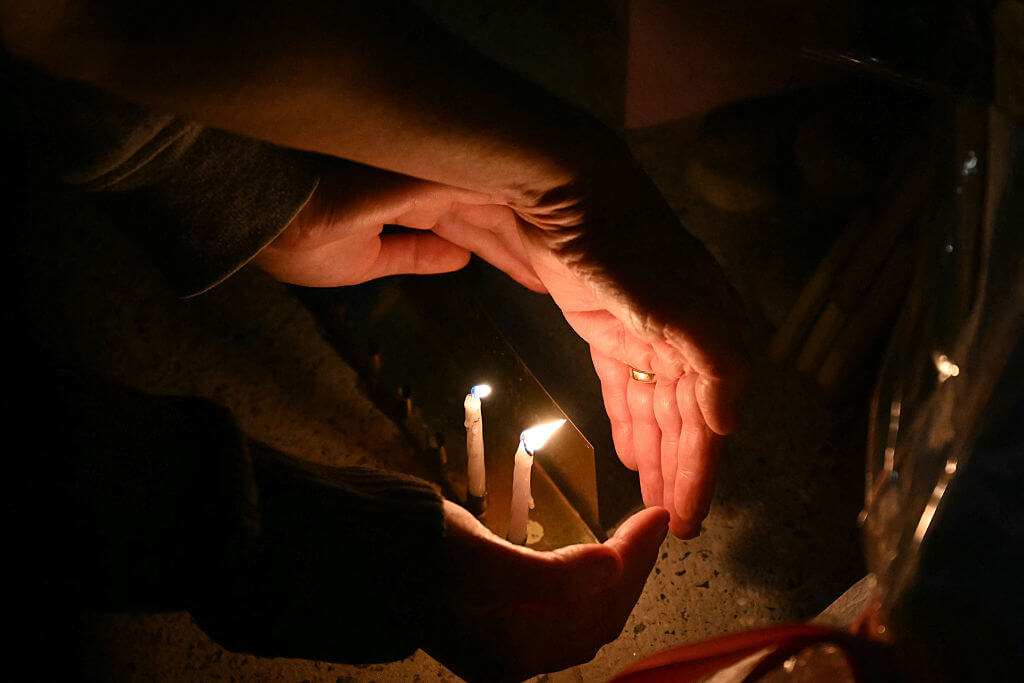My Fight To Lay Tefillin At an Orthodox School

Graphic by Angelie Zaslavsky
A young woman prays wearing tefillin on April 11, 2013 in Jerusalem, Israel. / Getty Images
On December 8, 2013, SAR High School principal Rabbi Naphtali Harcsztark permitted students Ronit Morris and Yael Marans to lay tefillin in the school’s daily women’s prayer group, allowing them to do so within the school building. While this is the first time in its 12-year history that SAR High School has faced this issue, SAR Academy, the associated elementary and middle school, has had female students who lay tefillin. So has Ramaz, another Modern Orthodox high school in New York.
I began laying tefillin when I was a seventh grade student at SAR, over thirteen years ago. Unlike in the case of Morris and Marans, the SAR administration barred me from praying with tefillin in the school building, and excused me from praying with my class. Instead, my prayer took place in my living room, before I left for school.
As a result of not being able to pray daily with the rest of my classmates, I missed out on a lot. Announcements were regularly made at the end of services, and I missed them. Students celebrated bnei mitzvah during services, and I missed them. I missed class jokes about the boy who always hit the ceiling when he did hagbah, the lifting of the Torah scroll, or the boys who (flirtatiously?) handed their tefillin to the girls for re-wrapping at the end of services. I missed the camaraderie of praying with my peers.
After graduating from the eighth grade, I attended Ramaz High School, where another student, Shifra Mincer, also began to lay tefillin. Shifra and I were excused from morning services, and prohibited from laying tefillin in school. However, there was one exception to this rule: Tuesday mornings.
On Tuesday mornings, Ramaz had a women’s prayer group, and we were permitted to lay tefillin there. We were also permitted to attend daily minyan at Kehilath Jeshurun, the synagogue affiliated with Ramaz. My weekly prayer schedule included praying at KJ twice a week, at local Conservative synagogue Or Zarua twice a week, and at women’s prayer at Ramaz once a week.
The reactions we got from the student body and the faculty were mixed. Not surprisingly, some students and faculty — particularly rabbinic faculty — reacted with belligerence. It became normal to refer to the two women who lay tefillin as women who wanted to be men, or as lesbians.
“The fact that it was so difficult for the community to accept my spiritual journey… made me realize how warped the community’s view on gender roles was,” Shifra recalls. “I realized they saw me as a woman more than they saw me as a student of Judaism and spiritual connection.”
Most students assumed that laying tefillin was a feminist statement, and feminism was certainly a bad word at Ramaz. No one entertained the possibility that tefillin was about making prayer, a hard experience in and of itself, easier. No one considered that laying tefillin was an attempt to remind ourselves of the yoke of heaven. No one acknowledged that most of the other women in school were getting nothing out of prayer, and doing everything to avoid it.
Shifra, who comes from a Modern Orthodox background, remembers the total apathy towards prayer that she experienced on the women’s side of the mechitzah, or gender barrier. “Most girls felt left out and ended up spending much of their time during davening in the bathroom fixing their hair or make-up. Or they stayed in the room and studied under their siddur.” There was a certain degree of irony to school rabbis going out of their way to criticize the two female students who were taking prayer seriously, while overlooking the majority of women who avoided it.
After I started laying tefillin, my prayer was no longer about fulfilling the expectations of a supervising teacher. Instead, prayer became my personal responsibility. I started praying on Sundays and vacations, and continue praying every morning to this day. Prayer became easier and more tangible.
But particularly at Ramaz, I learned what it meant to be known as a public enemy — maybe even a threat — by a segment of the Jewish community. Students referred to me as the crazed feminist, whose ideas and opinions could easily be discredited because of my supposed “radical” stance. In many ways, the organized Jewish community — particularly the Orthodox community — still feels like an antagonistic body, because I know its power to ostracize, bully and exclude.
While Morris and Marans have succeeded in finding a place in school that will accommodate them, they will still face significant challenges from the student body and the faculty. It will not be easy, and people will be mean. Congratulations to them for finding a makom tefillah, a place of prayer, in school, and to Rabbi Harcsztark for accommodating them.















